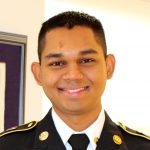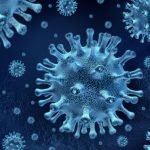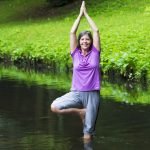PTSD: Using a Naturopathic Approach to Understand & Treat the Disorder
Radley M. Ramdhan
Stephanie Draus, ND
Naturopathic medicine is based on 6 principles: First Do No Harm (Primum Non Nocere); Doctor as Teacher (Docere); Identify and Treat the Cause (Tolle Causam); Healing Power of Nature (Vis Medicatrix Naturae); Treat the Whole Person (Tolle Totum); and Prevention (Praevenire). These principles guide us to a broad spectrum of opportunities and directions that are useful for helping our patients. We can utilize these 6 principles in understanding and treating any health condition that may present to us. One such condition that we can focus on as naturopathic doctors is Post-Traumatic Stress Disorder (PTSD).
PTSD is the development of characteristic symptoms, including a pathological anxiety affecting the nervous system, following exposure to 1 or more traumatic events.1 These events can include combat exposure, sexual or physical abuse, terrorist attacks, sexual or physical assault, serious accidents, or natural disasters.1
Our nervous system has a peripheral division known as the autonomic nervous system (ANS), which has a direct role in the physical response to stress.2 Within the ANS is a subdivision called the sympathetic nervous system (SNS), which generates a defensive fight-or-flight response when exposed to what we perceive as possible harm. A healthy response following an exposure to harm would involve turning on the fight-or-flight response while harm is perceived, but then experiencing a receding of the fight-or-flight response once it is determined that we are no longer in danger.2 Not all persons experiencing a traumatic event will develop PTSD; however, individuals with this condition are unable to turn off the fight-or-flight response and, as a result, are always trapped in that defensive state controlled by the ANS.2 Having this knowledge about the basis of PTSD, we can apply the 6 principles of naturopathic medicine to further understand and treat patients presenting with this condition.
Applying the 6 Principles to PTSD
First Do No Harm
The principle of First Do No Harm calls for a treatment approach that would be non-invasive and have little-to-no side effects. In order to avoid harm, we can spend appropriate time to understand the patients, as well as their situations leading them to develop PTSD. As naturopathic doctors, we can utilize multiple modalities within our tool kits to help our patients with PTSD. One option for achieving this end is a Mind-Body Medicine approach. Other effective techniques, proven to help PTSD, include talk therapy, Cognitive Behavioral Therapy (CBT), Eye Movement Desensitization and Reprocessing (EMDR), and Emotional Freedom Technique (EFT).
CBT is a form of psychotherapy based on the cognitive model suggesting that the way we perceive a situation affects our emotion. In a study conducted in Iran, using patients diagnosed with PTSD due to accident-related injuries, cancer, or domestic violence, CBT was found to significantly reduce the symptoms of PTSD.3 Similarly, a report review of effective psychotherapies for PTSD showed that CBT led to superior reductions in PTSD symptoms in a population that had experienced a variety of traumas, including childhood abuse survivors, combat veterans, and rape victims.4
EMDR is another form of psychotherapy that attempts to reprocess the way a memory has been stored in the brain, as well as the emotions associated with it. A meta-analysis on the findings of 26 randomized controlled trials of EMDR therapy for PTSD patients, conducted between 1991 and 2013, found that EMDR treatments were associated with significant reductions in symptoms of PTSD.5 The previously mentioned report review of effective psychotherapies for PTSD also listed EMDR as another therapy proven to reduce symptoms of PTSD.4 CBT and EMDR are 2 forms of treatment in current use by the US Department of Veteran Affairs for veterans and active-duty members who are affected by PTSD.
EFT is an energy-psychology form of treatment based on a combination of elements of cognitive therapy, somatic intervention, and brief exposure therapy. In a randomized controlled trial, EFT was found to have some efficacy in treating PTSD, including symptom reduction and the production of long-term effects.6 These are just some of the available modalities, each one non-invasive and with no proven side effects, that we may utilize in treating PTSD, under the guiding principle of First Do No Harm.
Doctor as Teacher
Another principle of naturopathic medicine is Doctor as Teacher. We as naturopathic doctors take every opportunity to educate our patients and give them a chance to feel empowered and to take charge of their health and well-being. We can inform our patients of possible risk factors that may predispose them to developing PTSD. In addition, we can talk to our patients about the importance of seeking help as early as possible after they experience a traumatic event, and educate them about the reduced risk associated with early intervention.
Some of our patients may be in a living situation or job environment that results in their exposure to repeated traumatic events, such as those living in war zones, high-crime areas, and domestic-abuse households, firefighters, EMTs, police, and soldiers. It is important to teach such patients methods for coping with traumatic events. As naturopathic doctors, we can teach our patients to use mindfulness and breathing techniques during stressful events. A 2012 study of patients diagnosed with PTSD as a result of the Iran-Iraq war found a significant increase in the quality of life and reduction in PTSD symptoms in the group receiving mindfulness training.7
Identify & Treat the Cause
Our next naturopathic principle is Identify and Treat the Cause. The major cause of PTSD is the exposure to a traumatic event. However, it is important to understand that different people can experience the same traumatic events while only some develop PTSD. There are many risk factors for developing PTSD, including genetic, neuroendocrine, neurochemical, and neuroanatomic.
In one group of trauma survivors, an excess of the SLC6A39 repeat allele (associated with a dopamine transporter polymorphism) was present in those that developed PTSD, and absent in those that did not develop the condition.8 Another study found that 4 single nucleotide polymorphisms (SNPs) on the FKBP5 gene acted as a predictor for developing PTSD.9 Neuroendocrine risk factors can include hypocortisolism, sustained increased levels of corticotrophin-releasing hormone (CRH), and abnormal T3:T4 ratios. Neurochemical risk factors can include increased concentrations of dopamine, norepinephrine, glutamate, and/or CSF β-endorphins, and decreased concentrations of serotonin (5-HT), gamma-aminobutyric acid (GABA) activity, and/or plasma neuropeptide-Y. Neuroanatomic risk factors that have been associated with PTSD include increased amygdala activity, reduced volume and activity of the hippocampus, reduced prefrontal volume, reduced anterior cingulate volume, and decreased medial prefrontal activation of the cortex.10
The understanding of PTSD as an underlying imbalance of the ANS allows us to appropriately address the issue. Craniosacral therapy (CST) is one therapy that can be used to address this ANS imbalance. A pilot study conducted in Switzerland concluded that CST has favorable effects on ANS imbalance.11 Adaptogenic herbs such as ashwagandha (Withania somnifera), rhodiola (Rhodiola rosea), licorice (Glycyrrhiza glabra), holy basil (Ocimum tenuiflorum), Asian ginseng (Panax ginseng) and Siberian ginseng (Eleutherococcus senticosus), have anti-stress properties that can also play a vital role in addressing the stress response in the ANS and reducing the effects of PTSD.
The Healing Power of Nature
Through the Healing Power of Nature, we can give the body what it needs, remove the toxins and stressors from the body, and then allow the body time to heal. With exposure to high levels of stress in PTSD patients, the body can more easily accumulate biotoxins and free radicals, which over time can cause other health conditions in these patients.
Naturopathic doctors can utilize herbs that assist the detoxification process, as well as support the body utilizing antioxidants and adaptogens. A high-antioxidant diet, including foods such as prunes, apricots, blueberries, strawberries, green tea, black tea, citrus fruits, broccoli, artichokes, kale, and spinach, can help reduce the effects of oxidative stress on the body. In addition, we can utilize adaptogenic herbs to improve coping mechanisms during stress. Another key factor we can address via the Healing Power of Nature is supporting the vitality of our patients via herbs and proper nutrition.
Treat the Whole Person
Each person reacts to traumatic situations differently, due to predisposing genetic factors, neurochemical, neuroendocrine, or neuroanatomical differences, or even individualized resiliency levels. Understanding this concept of individuality, we can apply the principle of Treat the Whole Person in treating our PTSD patients. As naturopathic doctors, we have to take into account the social, physical, mental, emotional, and genetic makeup of our patients. This begins with spending enough time with our patients to do a complete physical exam and comprehensive intake. From this we can gain vital information that helps us determine the most appropriate treatment for our patients based on their specific presentation. Furthermore, spending the time to do a comprehensive intake can serve as a form of talk therapy for our patients, as well as demonstrate to our patients our dedication to listening to their stories and helping them recover.
Prevention
One last, but very important principle of naturopathic medicine is Prevention. Preventing exposure to traumatic events may not always be possible; however, there are certain areas that we as naturopathic doctors can address to help our patients prepare to deal with traumatic events. Understanding the previously established predisposing risk factors can help us to address them with our patients.
In addition, providing proper nutrition plays an important role, as many amino acids, vitamins, minerals, and other nutrients play key parts in the biochemical pathways of the stress response. Some of these include thiamine (vitamin B1), niacinamide (vitamin B3), pantothenic acid (vitamin B5), pyridoxal 5’-phosphate (vitamin B6), methylcobalamin (vitamin B12), folate (vitamin B9), ascorbic acid (vitamin C), tryptophan, tyrosine, and phenylalanine.12 As a preventative approach, avoiding depletion of these vital nutrients may reduce the risk of our patients developing PTSD. Providing resiliency training to our patients, to address physical, mental, emotional, social, and spiritual strengthening, as well as educating them in stress management techniques, can also act as preventative measures. Helping patients who have previously been exposed to traumatic events but who may not have developed PTSD, as well as early intervention following traumatic event exposure, can be other ways of preventing PTSD in our patients.
Summary
As naturopathic doctors, we can utilize multiple treatment options from our tool kits, as well as gain training in additional modalities, to help support our patients with PTSD. We have the opportunity to understand our patients individually and treat each person individually, as opposed to simply treating the condition of PTSD. The 6 basic principles of naturopathic medicine can help to guide us to a better understanding of PTSD. As a result, we will have multiple treatment options available to provide personalized, patient-driven, and proactive care for our patients with PTSD.
 Radley M. Ramdhan is presently a student in the Doctor of Naturopathic Medicine and Master of Science in Acupuncture Program at the University of Bridgeport, CT. Radley also serves in the New York Army National Guard. Radley has a passion for and desire to work with both the veterans population and the pediatric population. Radley enjoys writing, traveling, and playing sports. He is currently working on his thesis “Understanding and Treating PTSD from a Naturopathic Approach.”
Radley M. Ramdhan is presently a student in the Doctor of Naturopathic Medicine and Master of Science in Acupuncture Program at the University of Bridgeport, CT. Radley also serves in the New York Army National Guard. Radley has a passion for and desire to work with both the veterans population and the pediatric population. Radley enjoys writing, traveling, and playing sports. He is currently working on his thesis “Understanding and Treating PTSD from a Naturopathic Approach.”
 Stephanie Draus, ND, is a graduate of NCNM and currently Associate Dean of Academic Affairs at the University of Bridgeport College of Naturopathic Medicine. Prior to this position, she was a full-time faculty member for several years at National University of Health Sciences, and the founder of a multidisciplinary practice, Stellaria Natural Health, in her hometown of Chicago. With an extensive background in the performing arts, Dr Draus is one of the first educators trained in “Medical Improv” – the use of improvisational theater techniques to improve communication skills in doctors and medical students, developed by Katie Watson of Northwestern University Feinberg Medical School.
Stephanie Draus, ND, is a graduate of NCNM and currently Associate Dean of Academic Affairs at the University of Bridgeport College of Naturopathic Medicine. Prior to this position, she was a full-time faculty member for several years at National University of Health Sciences, and the founder of a multidisciplinary practice, Stellaria Natural Health, in her hometown of Chicago. With an extensive background in the performing arts, Dr Draus is one of the first educators trained in “Medical Improv” – the use of improvisational theater techniques to improve communication skills in doctors and medical students, developed by Katie Watson of Northwestern University Feinberg Medical School.
References
- American Psychiatric Association, ed. Diagnostic and Statistical Manual of Mental Disorders. 5th Washington, DC: American Psychiatric Association; 2013.
- Howard S, Crandall MW. Post Traumatic Stress Disorder: What Happens in the Brain? Washington, DC: Washington Academy of Sciences; 2007. Available at: http://tinyurl.com/2d6xh82. Accessed October 15, 2015.
- Akbarian F, Bajoghli H, Haghighi M, et al. The effectiveness of cognitive behavioral therapy with respect to psychological symptoms and recovering autobiographical memory in patients suffering from post-traumatic stress disorder. Neuropsychiatr Dis Treat. 2015;11:395-404.
- Cloitre M. Effective psychotherapies for posttraumatic stress disorder: a review and critique. CNS Spectr. 2009;14(1 Suppl 1):32-43.
- Chen YR, Hung KW, Tsai JC, et al. Efficacy of eye-movement desensitization and reprocessing for patients with posttraumatic-stress disorder: a meta-analysis of randomized controlled trials. PLoS One. 2014;9(8):e103676.
- Church D, Hawk C, Brooks A, et al. Psychological trauma symptom improvement in veterans using emotional freedom techniques: a randomized controlled trial. J Nerv Ment Dis. 2013;201(2):153-160.
- Azad Marzabadi E, Hashemi Zadeh SM. The Effectiveness of Mindfulness Training in Improving the Quality of Life of the War Victims with Post Traumatic Stress Disorder (PTSD). Iran J Psychiatry. 2014;9(4):228-236.
- Segman RH, Cooper-Kazaz R, Macciardi F, et al. Association between the dopamine transporter gene and posttraumatic stress disorder. Mol Psychiatry. 2002;7(8):903-907.
- Binder EB, Bradley RG, Liu W, et al. Association of FKBP5 polymorphisms and childhood abuse with risk of posttraumatic stress disorder symptoms in adults. JAMA. 2008;299(11):1291-1305.
- Sherin JE, Nemeroff CB. Post-traumatic stress disorder: the neurobiological impact of psychological trauma. Dialogues Clin Neurosci. 2011;13(3):263-278.
- Girsberger W, Bänziger U, Lingg G, et al. Heart rate variability and the influence of craniosacral therapy on autonomous nervous system regulation in persons with subjective discomforts: a pilot study. J Integr Med. 2014;12(3):156-161.
- Head KA, Kelly GS. Nutrients and botanicals for treatment of stress: adrenal fatigue, neurotransmitter imbalance, anxiety, and restless sleep. Altern Med Rev. 2009;14(2):114-140.









